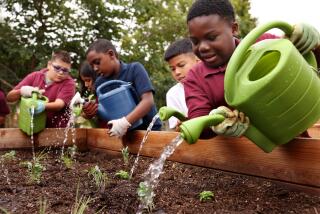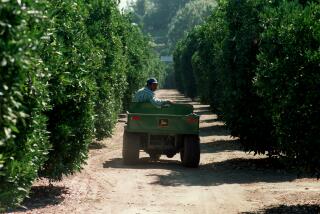Plan to Turn Garden Site Into Parking Lot Draws Fire : Environment: University officials say farming club must be evicted to make room for construction project. Those who till the land say they won’t go without a fight.
LONG BEACH — Working her small plot at the Cal State Long Beach Organic Garden, Kathy Smith carefully gathers a few late-season tomatoes and some deep-red peppers--just as she has gathered hundreds of pounds of pesticide-free fruits and vegetables for nine years.
The usually cheery harvest season is somber and bitter this year for Smith and nearly 200 other students, staff members and neighborhood green thumbs who have sown seeds for two decades on the two-acre parcel.
This will be their last season.
University officials recently announced that the lush strip of land near Bellflower Boulevard and State University Drive will be paved for use as a temporary parking lot.
“It’s a sad, sad loss,” said Smith, 42, a piano tuner in the music department. “It would be one thing if a building were going up, but a temporary parking lot?”
University administrators say the area is needed to provide 450 student parking spaces during the construction of a sports complex and parking structure on campus. About 2,200 spaces will be lost during the construction, which is expected to last into 1995.
“It’s the only spot we have available,” university Planning Director Tom Bass said. Twenty years ago, when the land was made available to the urban farmers, the campus had 100 acres of undeveloped land, he said. “It has since filled up.”
Bass said the garden will not be returned to the growers after the two-year construction period. The university will eventually develop the land, officials said. However, Bass is trying to find a location for the garden at El Dorado Park, about two miles from campus.
Members of the Organic Gardening Club, which maintains the garden area, said evicting them from the area is unnecessary, and they hope to persuade university officials to change their minds.
“We’re not going to lie down in front of the bulldozers or anything,” said Jim Baker, a Long Beach resident who has used the garden for about 10 years. “But we won’t go without a fight.”
A gardeners’ meeting last month drew about 80 people to the colorful plot, where a 10-member committee was chosen to figure out just what they can do to save the garden. They have begun a petition drive and a letter-writing campaign to the university president and other officials.
The university gave the land to the Associated Student Body in 1970 in celebration of Earth Day. By the end of the decade, growers from outside the university were allowed to use the garden, and a volunteer committee was put in charge of running it.
The university supplies the water, and the gardeners pay $5 a year to work a 15-foot-square plot.
Members say hundreds of varieties of vegetables, fruits, herbs and other plants are grown in the garden. About twice a week, excess food is donated to Food Finders, a nonprofit group that feeds the homeless. Food Finders spokeswoman Marsha Green said the gardeners have donated 920 pounds of produce this year.
For some of the senior citizens who work the land, it is a loss of therapy and recreation, they said. Other growers lament the loss of fresh, chemical-free produce for their tables. And the resident rat catcher, a tabby named Pancho, will have to find a new home.
“This is one of the few opportunities to get this diverse of a group together for a common interest,” said Terry Mullin, a Golden West College student who finally got a plot last summer after spending eight months on a waiting list.
“To me, this place really represents the whole community--with African-Americans, Laotians, Latinos and Caucasians of all ages.”
University officials say the gardeners have until the end of February to clear out of their plots.
More to Read
Sign up for Essential California
The most important California stories and recommendations in your inbox every morning.
You may occasionally receive promotional content from the Los Angeles Times.










